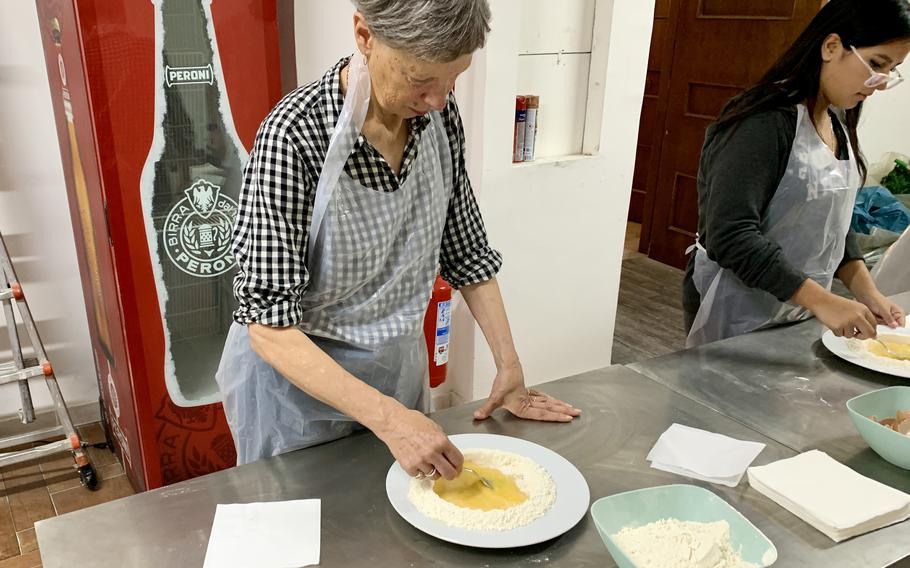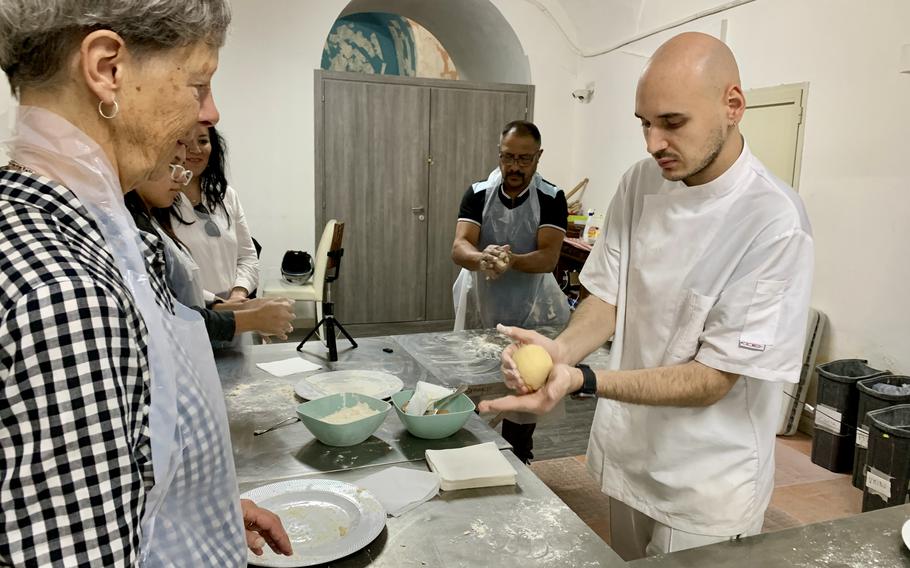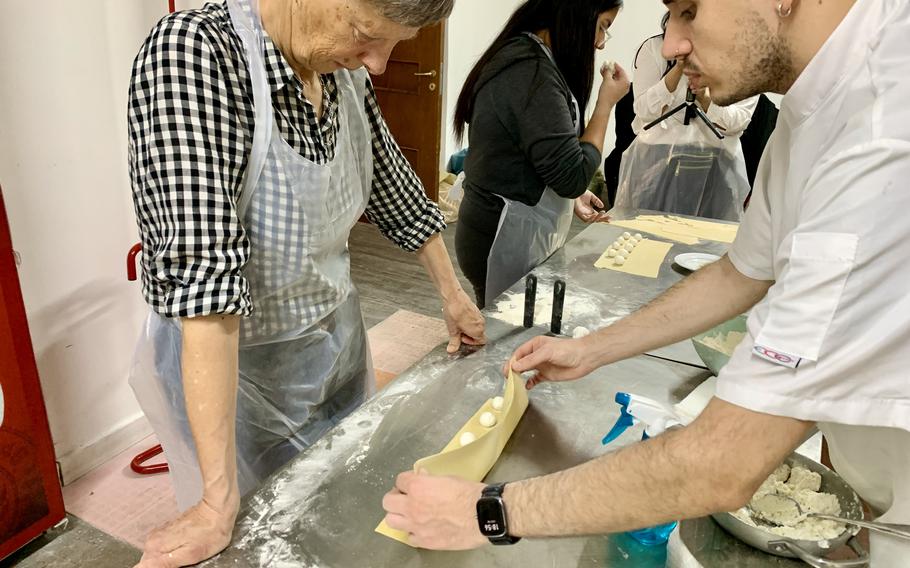
Naples Bay Tours' offerings include a class held at a restaurant in Naples, Italy, where participants learn to make tagliatelle and ravioli. At the end, students get to eat their pasta creations during a family-style meal. (Alison Bath/Stars and Stripes)
Most of the people who take a class on handmade pasta in Naples probably will never make the Italian cuisine staple ever again, given how labor-intensive it is and the availability of great pasta in the city.
But that doesn’t mean you should pass on getting your hands sticky making pasta with a group of similar-minded foodies.
The 2 1/2-hour class I took with Naples Bay Tours offers participants the opportunity to learn the pasta-making basics used by Neapolitan nonnas, or grandmothers, while reveling in the city’s food culture.

Participants in a pasta-making class in Naples, Italy, on Dec. 3, 2024, get plenty of hands-on experience in using a pasta recipe favored by Neapolitan nonnas, or grandmothers, to make tagliatelle and ravioli. (Alison Bath/Stars and Stripes)
On a recent Tuesday evening, I joined four other aspiring pasta chefs at Mammina pizzeria just off the ancient street of Via Toledo in central Naples, although the restaurant is not affiliated with the class.
Offered twice a day, the class focuses on ravioli and fettuccine Alfredo, or rather the Italian version of the dish. Minutes into our class, our instructor, a lifelong Neapolitan who has been cooking since he was in his early teens, patiently explained that the long, wide noodles called fettuccine in the U.S. don’t exist in Italy.
The closest comparison of American fettuccine Alfredo for Italians is tagliatelle with butter, Parmesan cheese and sage. “That’s it,” he said.

This standard pasta recipe in Naples, Italy, includes just three ingredients: eggs, double-zero flour and salt. (Alison Bath/Stars and Stripes)
With that knowledge, we cracked two eggs into the middle of some finely ground double zero flour and added a little salt. Just three ingredients are in the standard pasta recipe used by Italian grandmothers everywhere, our instructor said.
It was important to whisk the eggs until foamy first without incorporating the flour, which is high in protein and offers the smooth texture and elasticity needed for pasta. Before long, it was time to knead the dough.

A class instructor in Naples, Italy, on Dec. 3, 2024, demonstrates how to shape pasta dough into a ball, which is then covered and allowed to rest for about 20 minutes before being rolled into sheets. (Alison Bath/Stars and Stripes)
This took time, muscle and patience as our instructor explained how to shape the dough and then push an indentation into the resulting ball to see if it was ready.
If the indentation bounces back, it’s time to cover the dough and let it rest. In Italy, this is known as putting the pasta to bed or “buona notte,” which means good night.
With 20 minutes on our hands, we were seated at a table and offered an appetizer of warm zeppole, deep-fried dough balls that are a typical Neapolitan snack and our instructor’s favorite. The platter also included bruschetta, or grilled bread with chopped tomatoes and basil.
The break offered a chance to taste traditional cuisine and share in the joy of eating together, which is important in Italian culture.

Ravioli and tagliatelle in progress during a pasta-making class in Naples, Italy. The class is held twice a day at a restaurant just off the famed Via Toledo. (Alison Bath/Stars and Stripes)
After learning a little more about one another — three of my classmates were a family on vacation from Irvine, Calif., and the other an Australian finishing up a few months tour of Italy and France — we were back at the hard work of making pasta.
The elasticity of the dough requires patient stretching in a large, thin circle using two different types of wooden rolling pins. Giving it our best try, each of us ultimately needed our instructor’s assistance to roll out the dough nearly paper-thin.
This meant lifting up a portion of the flattened disc and putting your hand behind it. Dough that is thin enough has a sort of transparency that allows you to see your fingers, our instructor advised.
We then cut off the edges of the circle to make a square, saving the trimmings for later. “Nothing goes to waste,” our instructor said.

An instructor shows how to properly fold dough over filling for ravioli as part of a pasta-making class in Naples, Italy, on Dec. 3, 2024. (Alison Bath/Stars and Stripes)
Half of the square would become ravioli, filled with fresh ricotta and some Parmesan cheese seasoned with a little salt, pepper and olive oil.
The other half would become the tagliatelle, rolled horizontally, cigar-style, at a width about the size of a pinkie finger. We cut the roll vertically at index-finger widths, unwrapping the resulting pinwheels into long strips, and cut the leftover trimmings to match.
Our work was done. It was now time for our instructor to boil the pasta, not more than 4 or 5 minutes, and make the sauces to accompany it.

A 2.5-hour pasta-making class offered in Naples, Italy, includes an appetizer of fried dough balls called zeppole and bruschetta with tomatoes. Participants also get to eat the pasta they make and take home the recipes. (Alison Bath/Stars and Stripes)
The ravioli came out first, blanketed in a sauce of sauteed San Marzano tomatoes accented with a touch of Parmesan. The buttery tagliatelle, or “fettuccine Alfredo,” was next.
We savored each expertly prepared dish while sitting family-style around a dining table decorated with an iconic, red-checked tablecloth, swapping stories about what brought us to Naples.
The class ended in a toast with limoncello, a lemon-flavored liqueur, and the presentation of pasta chef diplomas that included a QR code to an online site with recipes.
Fettuccine Alfredo and ravioli class
Address: Via Santa Brigida 65, Naples, Italy
Cost: 42 euros, including appetizer, drink and pasta lunch or dinner. Classes are kid-friendly; they are not wheelchair accessible. Instruction is in English.
Hours: 11 a.m. and 5:30 p.m. daily; reservations required
Information: Online: naplesbay.it/en/prodotto/lesson-of-the-egg-pasta